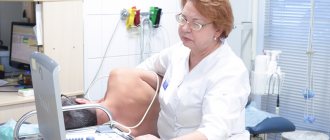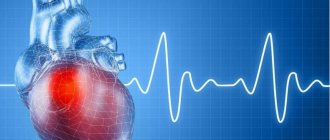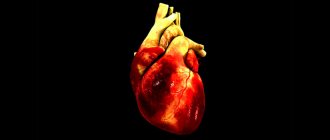One of the most important components of a successful fight against conditions after a heart attack is strict adherence to a certain regimen by the patient and compliance with the prescribed recommendations. Often, if patients remember to take a long list of medications prescribed by a doctor, they do so at the wrong time and not systematically. It is in order to monitor unquestioning compliance with the treatment regimen and provide proper care for a patient who has suffered a heart attack, it is necessary to place him in a hospital setting for at least two weeks. After a positive trend and stabilization of the patient’s condition, he can be discharged home.
Possible symptoms of myocardial infarction:
- pain in the chest area and a feeling of compression of the chest;
- arrhythmic heartbeat and increased heart rate;
- dizziness and cold sweat;
- feeling of immense fatigue, drowsiness and possible loss of consciousness;
- stomach pain and nausea.
From the outside, a person having a heart attack may appear confused, unfocused, and very pale. If you observe such symptoms in yourself, a loved one or a stranger, do not hesitate to call an ambulance. If the diagnosis is confirmed, the patient must be hospitalized in a medical facility.
Features of home care
For complete rehabilitation, the patient needs bed rest . For people who have suffered a myocardial infarction, it is necessary to create the most comfortable conditions for a long stay in a supine position.
Also, the rehabilitation course includes mandatory protection of the patient from various stresses and experiences . It is very important not only to provide high-quality and comfortable conditions, but also to provide moral support to the person so that he does not feel like a burden to his loved ones.
Post-infarction rehabilitation is a feasible task for the Zagorskie Dali sanatorium
A stay in our sanatorium after a myocardial infarction is guaranteed to provide the patient with not only a comfortable stay and proper care, but also a high-quality rehabilitation course and a set of restorative procedures for the body as a whole. Having a patient in a sanatorium also eases the lot of relatives and friends, often elderly people, who are often responsible for caring for and monitoring relatives who have suffered from an illness. Our qualified specialists will do everything for you in accordance with the instructions and using an individual approach to each patient.
Advantages of staying at the Zagorskie Dali sanatorium for rehabilitation:
- territorial proximity to Moscow, convenient location, familiar and familiar climate;
- favorable environmental conditions, beautiful nature, modern equipment;
- qualified personnel, provision of appropriate treatment and care, individual approach;
- a special set of rehabilitation procedures;
- adequate nutrition for patients;
- 24-hour monitoring of the condition and well-being of patients, and, if necessary, high-quality medical care is provided;
- favorable atmosphere of home comfort;
Staying in the sanatorium of the Federal State Budgetary Institution "Zagorskie Dali" after a heart attack and not only is the key to effective treatment and high-quality rehabilitation in pleasant conditions and a feeling of complete harmony with oneself. Your health is in our hands!
Rehabilitation after a heart attack
After a heart attack, in order to normalize the patient’s condition, it is recommended that he spend the first two weeks in a hospital setting, where he will be provided with proper care. Staying in a hospital after such an illness is very important for monitoring the patient’s health. After the condition has stabilized, the patient is discharged and can go home for further rehabilitation.
The main task for proper care of a patient after a heart attack is complete and unquestioning compliance with all recommendations of specialists . In most cases, the patient is prescribed a considerable list of medications that must be taken according to a specially prescribed regimen. A person after a heart attack is practically unable to carry out any household chores on his own, much less monitor compliance with doctors’ orders. Such responsibilities do not fall on the shoulders of the patient’s relatives.
How to prevent first and second heart attacks
To protect yourself from heart attack and complications, you need to follow simple and well-known conditions:
- Quit smoking, which causes damage to blood cells and disrupts the function of the heart and blood vessels.
- Lower cholesterol levels to reduce the accumulation of atherosclerotic plaques and the development of atherosclerosis, which causes a heart attack.
- Pay attention to physical activity. A sedentary lifestyle increases the risk of gradual changes in the arteries, and then the appearance of atherosclerosis.
- Stick to a diet. Excess weight is accompanied by the accumulation of deposits in the blood vessels and the gradual development of atherosclerosis.
- Blood pressure control. A sharp change in blood pressure leads to micro-tears in the walls of the artery. They heal and become the site of fatty plaque formation. High blood pressure makes the arteries less elastic, which also increases the risk of atherosclerosis.
Recommendations on the frequency of the rehabilitation course
Only your attending physician can give precise instructions and formulate contraindications. It is worth understanding that recovery also puts some strain on the body. And it will be important to make sure that this action does not cause harm.
First, remember that after emergency intervention or during an exacerbation, long, grueling trips are generally contraindicated.
Secondly, literally “living” in a health center is also not a good idea. Many procedures are periodic. They can be used two to three times a year in complex conditions. The rest of the time you can stay in the health resort, but just for relaxation.
Having studied our small list, we can conclude that there are a huge number of cardiac sanatoriums where the heart, blood vessels, vascular diseases and other disorders of internal organs are treated in our country. And what is no less interesting is that the quality of their work has now significantly increased compared to ten years ago. Now, for such purposes, there is no point in leaving the Russian Federation; the European level of procedures and service can easily be found in Crimea or the Moscow region. To choose the best place for relaxation and treatment, contact the travel agency “Let’s go and fly” - we will organize your vacation in the best possible way at an inexpensive price.
Doctors and specialists of the sanatorium
Ivanov Evgeniy Valentinovich Chief physician Graduated from the 2nd Moscow Medical Institute named after. N.I. Pirogova Experience: 37 years
Matyushina Natalya Petrovna Deputy Chief physician for medical work Graduated from the Moscow Medical Dental Institute Experience: 25 years
Timoshina Irina Anatolyevna Clinical laboratory diagnostics doctor Graduated from Rostov State University Experience: 35 years
Elena Anatolyevna Kozlova Therapist Graduated from Blagoveshchensk State Medical Institute Experience: 32 years
Krupnov Georgy Borisovich Neurologist, Reflexotherapist Graduated from Saratov Medical Institute Experience: 37 years
Ignatiev Andrey Viktorovich Doctor in functional and ultrasound diagnostics Graduated from Yaroslavl Medical Institute Experience: 36 years
Lyashenko Maria Aleksandrovna Cardiologist Graduated from Moscow State Medical and Dental University named after. A. I. Evdokimova Experience: years
Tremaskina Marina Sergeevna Cardiologist Graduated from Moscow State Medical and Dental University Experience: 12 years
Skorobogatov Marat Yuryevich Psychotherapist Graduated from Tyumen State Medical Institute Experience: 31 years
Support stage
It includes following a diet, maintaining a healthy lifestyle, physical activity, taking maintenance medications, as well as regular monitoring by specialists. This stage of rehabilitation continues throughout the rest of life: following the prescribed recommendations helps reduce the risk of recurrent attacks.
Important - approximately 20% of all deaths from myocardial infarction occur in the first hour of the attack. The reason for this is not the low quality of medicine: the patient simply does not recognize the symptoms of the disease or loved ones are not able to provide first aid. If you or your relatives are at risk, it is recommended to carefully study the manifestations of this disease and take first aid courses!
What are early post-infarction consequences?
They develop within a period of several hours to three to four days after the attack:
- acute left ventricular failure, which appears when the contractile function of the heart decreases and is recognized by the presence of shortness of breath, cough, tachycardia;
- cardiogenic shock develops due to a serious deterioration in the ability of the muscle to contract, caused by a large area of dead tissue;
- rhythm disturbances and cardiac conduction disturbances are recorded in 90% of cases;
- attacks of early post-infarction angina occur or become more frequent within a day and last up to eight weeks;
- pericarditis is an inflammatory process of the pericardial lining of the heart, which occurs on days 1–3. It manifests itself as pain, which increases or decreases depending on the position of the body, and an increase in temperature.
After a heart attack, in 15–20% of cases, an aneurysm forms: the wall of the heart becomes thinner and bulges. More often this happens to the left ventricle after extensive muscle damage.
Separately, it is necessary to say about thromboembolic consequences. The lumen in the vessels may be completely or partially blocked by blood clots. This often happens if there are varicose veins, bleeding disorders, or prolonged bed rest.
Deterioration of blood supply can cause gastrointestinal problems: erosions, acute ulcers. There are also mental disorders: depression, psychosis.
Recovery methods
In each of the periods considered, a set of measures is used that help the body recover after an attack. This includes taking medications, exercise, diet, and, of course, lifestyle changes.
Drug rehabilitation
Modern approaches to the treatment of acute myocardial infarction involve restoration of blood flow through the infarct-related artery. It can be performed using thrombolytic therapy or by emergency endovascular intervention with stent placement, which is the most effective method. It allows you to completely restore coronary blood flow in more than 90% of cases. At the same time, thrombolytic therapy is considered as a temporary measure (if it is not possible to carry out an endovascular intervention within two hours), since it allows one to begin rescuing the patient immediately, even at the prehospital stage, without wasting time on transporting the patient. In some cases, coronary artery bypass surgery is required.
Pain relief is carried out by intravenous fractional administration of a narcotic analgesic. Antithrombotic therapy is performed to prevent the recurrence of blood clots (rethrombosis). Anticoagulant therapy is used according to indications. Statins are prescribed to lower cholesterol levels. In the presence of complications of acute myocardial infarction, such as cardiogenic shock, acute left ventricular failure, cardiac arrhythmias, mechanical complications of myocardial infarction, etc., appropriate treatment is also prescribed.
During the post-inpatient and maintenance periods of rehabilitation, therapy is prescribed individually depending on the presence of concomitant diseases and the characteristics of the body. These could be drugs to lower blood pressure, relieve swelling, normalize cholesterol levels, and so on. It is extremely important, especially in the first months after a heart attack, to regularly monitor the patient’s condition: if it worsens, the doctor can promptly prescribe the necessary medications to the patient.
Physical rehabilitation after a heart attack
Particular attention is paid to the restoration of physical skills from the first days after a heart attack. The process begins in the hospital with the most minor physical activity - returning the skills to sit and turn on the bed, wash yourself, and brush your teeth. As the damaged tissue scars, doctors allow the patient to do simple gymnastics, move around the ward, and then along the hospital corridor and stairs.
After inpatient treatment, physical activity gradually increases: walking and therapeutic exercises are considered especially useful. It is recommended to start with 15 minutes of exercise per day, increasing the time by five minutes weekly until the duration of physical activity reaches an hour. However, a doctor should determine the amount and type of exercise: excessive zeal can lead to negative results.
Mental rehabilitation
In the first weeks after an attack, it is very important to work on the patient’s psychological state: right now he is faced with an awareness of his illness and its consequences, feels helpless, and experiences acute fear of a second heart attack. Relatives complain of increased irritability of the patient, sometimes even aggression. In such a situation, one cannot do without the help of a psychologist - he will help the patient accept the situation and understand that a heart attack is not a death sentence.
Restoring a positive attitude has a beneficial effect on the speed of recovery, so do not neglect contacting specialists.
Diet
Proper nutrition is one of the keys to recovering from a heart attack and preventing recurrent heart attacks.
In the first days in the hospital, to reduce the load on the heart, the patient's portions are reduced; the diet includes soups and pureed foods without salt and spices. During the period of scarring, nutrition becomes plentiful, but the restriction on the intake of salty and fatty foods remains.
In subsequent stages of rehabilitation, following the principles of proper nutrition should become habitual: small portions, exclusion of unhealthy foods (fatty, salty, sweets, sauces and spices) from the diet and, on the contrary, inclusion of fresh vegetables, fish and seafood, and lean meats. You should drink no more than one to one and a half liters of liquid per day.
People with increased body weight should bring their weight back to normal. Of course, we are not talking about a strict diet, but only about reducing the caloric content of the diet to acceptable levels.
Lifestyle
It’s not for nothing that bad habits are called harmful: they cause significant damage to human health and provoke serious illnesses. Those who have experienced myocardial infarction will have to reconsider their lifestyle - give up smoking and alcohol, and introduce regular physical activity at an intensity that is optimal for the person’s current condition. Proper sleep and rest are also important.
Rehabilitation after a heart attack and heart surgery (for example, stenting) is essential for the patient to return to normal life. However, this life will be radically different from the previous one: the patient will have to change his habits and tastes. In order for recovery to go as smoothly as possible, without stress and “breakdowns,” it is necessary to pay maximum attention to the recovery period, which will help form the right habits and life attitudes.
Stages of cardiac rehabilitation: what the program consists of
STAGE 1
Assessment of the clinical picture of the course of the disease, concomitant pathology and individual capabilities of the patient. Selection of an individual rehabilitation regime: gentle, gentle-training or training
This part of the program includes:
General clinical examination by the attending physician. Studying the medical history, identifying risk factors for cardiovascular diseases, examination, assessing exercise tolerance, psycho-emotional status, and the presence of complications from an incident or operation.
Functional assessment of the state of the cardiovascular system.
- 12-lead electrocardiogram (ECG) to evaluate coronary circulation, rhythm, conduction
- Echocardiographic examination of the heart (EchoCG) to assess myocardial contractility, central and intracardiac hemodynamics
- Determination of the patient's functional abilities (stress tests - bicycle ergometry, treadmill test, 6-minute walk test)
Conducting laboratory examination methods.
- Complete blood count to detect anemia, inflammatory response
- Biochemical blood test to assess lipid spectrum, glycemic levels, renal and liver function (to exclude renal failure and liver dysfunction)
STAGE 2
Management of patients according to an individual program and correction of treatment methods used based on the results of daily monitoring
The second stage includes:
Physical rehabilitation:
Training walking, therapeutic exercises in aerobic mode using a complex of cardio exercise equipment, therapeutic exercises in strength mode, therapeutic massage, swimming in the pool.
Classes are conducted under individual supervision. If necessary, amendments are made to the training regimens, and the patient can be transferred to a higher or lower level of training. In patients with a high risk of cardiovascular complications and concomitant severe pulmonary pathology, training is carried out using an oxygen concentrator.
Restoration of myocardial function, general improvement of the body using various methods of physiotherapy.
- Magnetotherapy
- Hardware breathing training
- The use of balneotherapy (dry carbon dioxide baths, general and chamber baths, hydromassage, fan and circular showers)
- According to indications, use of the method of external enhanced counterpulsation
Psychological rehabilitation.
Includes individual psychotherapy. Treatment is aimed at developing in the patient a sense of optimism, self-confidence, restoring a holistic internal image of oneself, and drawing the line between oneself and the disease.
The participants in psychotherapy are the attending physician, a psychotherapist, and the environment itself, nature, the rhythm of life and the friendly staff of the sanatorium.
STAGE 3
Conducted simultaneously with stage 2.
Prevention of the progression of atherosclerosis (use of programs to combat risk factors for cardiovascular diseases) This stage of the program is very important, since even a minor change in the patient’s lifestyle can significantly improve its quality.
This stage includes:
- Smoking cessation Methods: limiting the use of tobacco, motivating the patient and his family to quit smoking and not continue it, conducting interviews, using psychotherapy
- Achieving optimal blood pressure values Methods: correction of the diet, increasing the patient’s physical activity, drug therapy with the selection of drugs individually for each patient
- Achieving an optimal level of blood lipid spectrum Methods: diet therapy in all patients, increasing physical activity and weight correction. Increasing intake of omega-3 polyunsaturated fatty acids. If necessary, prescribe drug therapy
- Increase physical activity Minimum 30 minutes 3-4 days a week. Optimal regimen - daily training Methods: training walking on health paths, cardio equipment, swimming in the pool
- Reducing excess body weight Methods: diet therapy, physical activity and training
- Correction of carbohydrate metabolism Achieving optimal levels of blood glucose and glycated hemoglobin Methods: diet therapy, administration of glucose-lowering therapy, control of other risk factors (physical inactivity, excess weight, arterial hypertension, hypercholesterolemia)
Sanatoriums in Russia with treatment of the cardiovascular system, how to choose the appropriate option
The main thing for the customer is not to focus on a loud brand or loud advertising, but to identify a list of purely personal requirements that the establishment must meet. And then see what is on the market that meets the stated requirements.
The following factors are most often important:
- Price level. A kopeck saves the ruble. The question becomes especially important if you go on vacation and for treatment several times a year. In this scenario, using the services of expensive establishments may not be the wisest choice. Although, no one cancels the stereotype, the higher the price, the better the quality. But I still don’t want to overpay for a trip.
- Programs.








